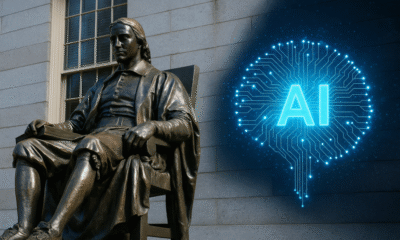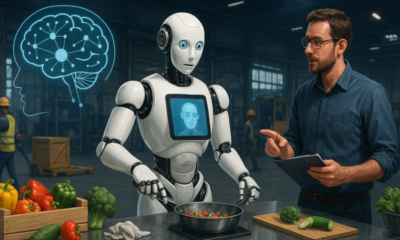Artificial Intelligence
Why AI Still Can’t Grasp Basic Physics Like Humans

Artificial intelligence can beat world champions at chess, generate stunning artwork, and write code that would take humans days to complete. Yet when it comes to understanding why a ball falls down instead of up, or predicting what happens when you push a glass off a table, AI systems often struggle in ways that would surprise a young child. This gap between AI’s computational prowess and its inability to understand basic physical intuition reveals key limitations about current form of artificial intelligence. While AI excels at pattern matching and statistical analysis, it lacks a deep understanding of the physical world that humans develop naturally from birth.
The Illusion of Understanding
Modern AI systems, particularly large language models, create an illusion of understanding physics. They can solve complex equations, explain thermodynamics principles, and even help design experiments. However, this apparent competence often hides fundamental limitations.
Recent studies show that while AI tools demonstrate strong performance in theory-based questions, they struggle with practical problem-solving, particularly in areas requiring deep conceptual understanding and complex calculations. The difference becomes especially clear when AI systems encounter scenarios that require true physical reasoning rather than pattern recognition.
Consider a simple example: predicting the trajectory of a bouncing ball. A human child quickly learns to anticipate where the ball will land based on intuitive physics developed through countless interactions with objects. AI systems, despite having access to precise mathematical models, often fail to make accurate predictions in real-world scenarios where multiple physical principles apply.
How Humans Learn Physics Naturally
Human understanding physics begins before we can even walk. Babies show surprise when objects appear to violate basic physical laws, suggesting an innate foundation for physical reasoning. This early intuitive physics develops through constant interaction with the physical world.
When a toddler drops a toy, they are conducting physics experiments. They learn about gravity, momentum, and cause-and-effect relationships through direct experience. This embodied learning creates robust mental models that generalize new situations.
Humans also possess remarkable abilities to simulate physics mentally. We can visualize what will happen if we tilt a glass of water or imagine the path of a thrown object. This mental simulation allows us to predict outcomes without complex calculations.
The Pattern Recognition Trap
AI systems approach physics problems fundamentally differently than humans. They rely on pattern recognition across vast datasets rather than building conceptual models of how the world works. This approach has both strengths and critical weaknesses.
When encountering familiar problems that match their training data, AI systems can appear remarkably competent. They can solve textbook physics problems and even discover new patterns in complex scientific data. However, this success is often brittle and fails when faced with novel situations.
The core issue is that AI systems learn correlations without necessarily understanding cause-and-effect. They might learn that certain mathematical relationships predict certain outcomes without understanding why those relationships exist or when they might break down.
The Challenge of Compositional Reasoning
One of the key limitations of current AI systems is their difficulty with what researchers call “compositional reasoning.” Humans naturally understand that complex physical phenomena result from the interaction of simpler principles. We can break down complicated situations into component parts and reason about how they interact.
AI systems often struggle with this kind of hierarchical understanding. They might excel at recognizing specific patterns but fail to understand how basic physical principles combine to create more complex behaviors. This limitation becomes particularly apparent in scenarios involving multiple interacting objects or systems.
For instance, while an AI might accurately solve isolated problems about friction, gravity, and momentum, it may struggle to predict what happens when all three factors interact in a novel configuration.
The Embodiment Problem
Human physics intuition is deeply connected to our physical experience of the world. We understand concepts like force and resistance through our muscles, balance through our inner ear, and momentum through our movement. This embodied understanding provides a rich foundation for physical reasoning.
Current AI systems lack this embodied experience. They process physics as abstract mathematical relationships rather than as lived experiences. This absence of physical embodiment may be one reason why AI systems often struggle with seemingly simple physical reasoning tasks that young children master easily.
Research in robotics and embodied AI is beginning to address this limitation, but we are still far from systems that can match human physical intuition developed through a lifetime of bodily interaction with the world.
When Statistics Meet Reality
AI systems excel at finding statistical patterns in large datasets, but physics is not just about statistics. Physical laws represent fundamental truths about how the world works, not just observed correlations. This distinction becomes crucial when dealing with edge cases or novel situations.
Recent research demonstrates that AI generally struggles to recognize when they get things wrong, particularly in areas requiring deep conceptual understanding. This lack of self-awareness about their limitations can lead to confident but incorrect predictions in physical scenarios.
The Simulation Gap
Humans naturally run mental simulations of physical scenarios. We can imagine dropping an object and predicting its trajectory, or visualize the flow of water through a pipe. These mental models allow us to reason about physics in ways that go beyond memorized formulas.
While AI systems can run sophisticated physics simulations, they often struggle to connect these simulations to intuitive understanding. They might accurately model the mathematical behavior of a system without understanding why that behavior occurs or how it might change under different conditions.
The Context Problem
Human physics intuition is remarkably flexible and context-aware. We automatically adjust our expectations based on the situation. We know that objects behave differently in water than in air, or that the same principles apply differently at different scales.
AI systems often struggle with this kind of contextual reasoning. They may apply learned patterns inappropriately or fail to recognize when context changes the relevant physical principles. This inflexibility limits their ability to handle the rich, varied physical scenarios that humans navigate effortlessly.
The challenge is not just technical but conceptual. Teaching AI systems to understand context requires more than better algorithms; it requires fundamental advances in how we approach machine understanding.
Beyond Pattern Matching
The limitations of current AI in physics understanding point to deeper questions about the nature of intelligence and understanding. True physical intuition seems to require more than pattern recognition and statistical analysis.
Humans develop what might be called “causal models” of the physical world. We understand not just what happens, but why it happens and under what conditions. This causal understanding allows us to generalize to new situations and make predictions about scenarios we have never encountered.
Current AI systems, despite their impressive capabilities, primarily operate through sophisticated pattern matching. They lack the deep causal models that seem essential for robust physical reasoning.
Future Directions
Researchers are actively working on several approaches to bridge the gap between AI computation and human-like physics understanding. These include developing more sophisticated reasoning models, incorporating embodied learning, and creating systems that can build and test causal models of the physical world.
Recent advances include deep-learning systems inspired by developmental psychology that can learn basic rules of the physical world, such as object solidity and persistence. While promising, these systems still fall far short of human intuitive physics. The real challenge is not about developing technical solutions, it’s about addressing fundamental questions about intelligence, understanding, and the nature of knowledge itself.
The Bottom Line
While AI continues to advance rapidly in many areas, basic physics understanding remains a significant challenge. The gap between human intuition and AI capability in this domain reveals fundamental differences in how biological and artificial systems process information about the world.
The journey toward AI systems that truly understand physics like humans do will likely require fundamental breakthroughs in how we approach machine learning and artificial intelligence. Until then, the three-year-old who confidently predicts where a bouncing ball will land remains ahead of our most sophisticated AI systems in this fundamental aspect of intelligence.












